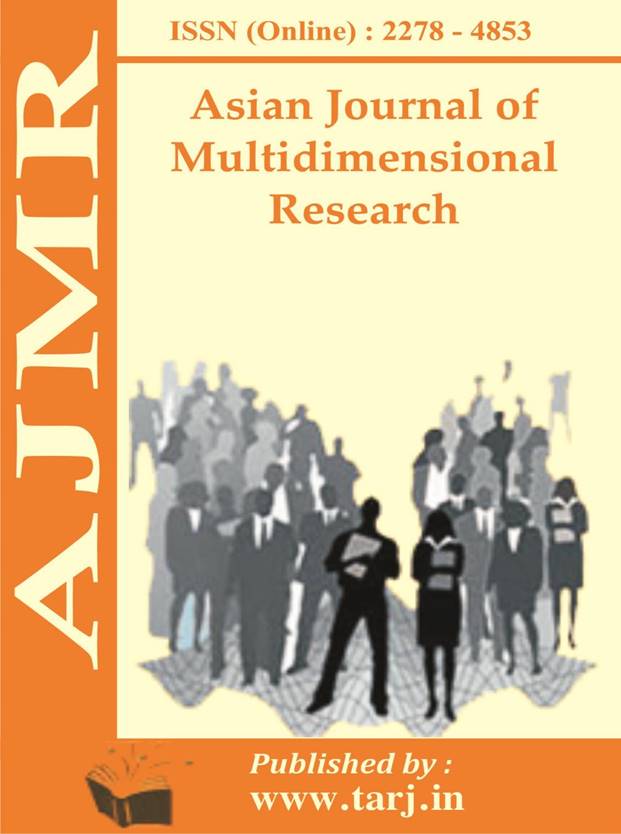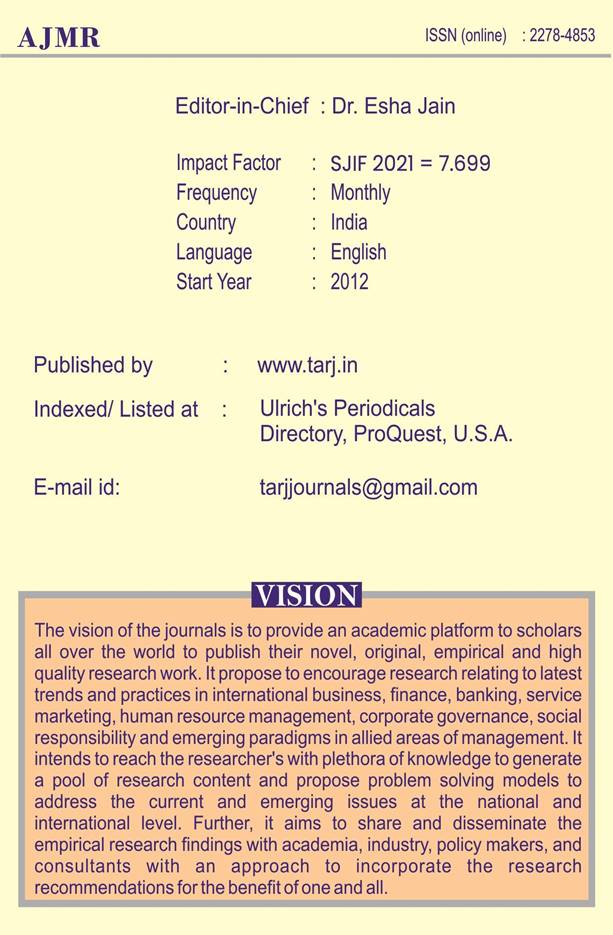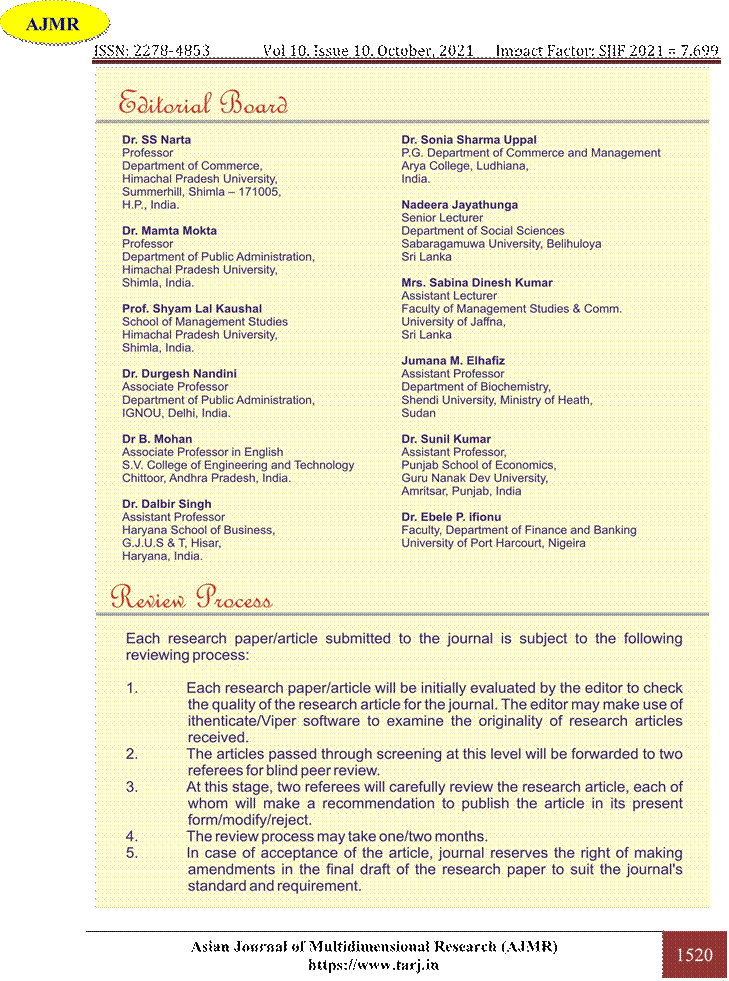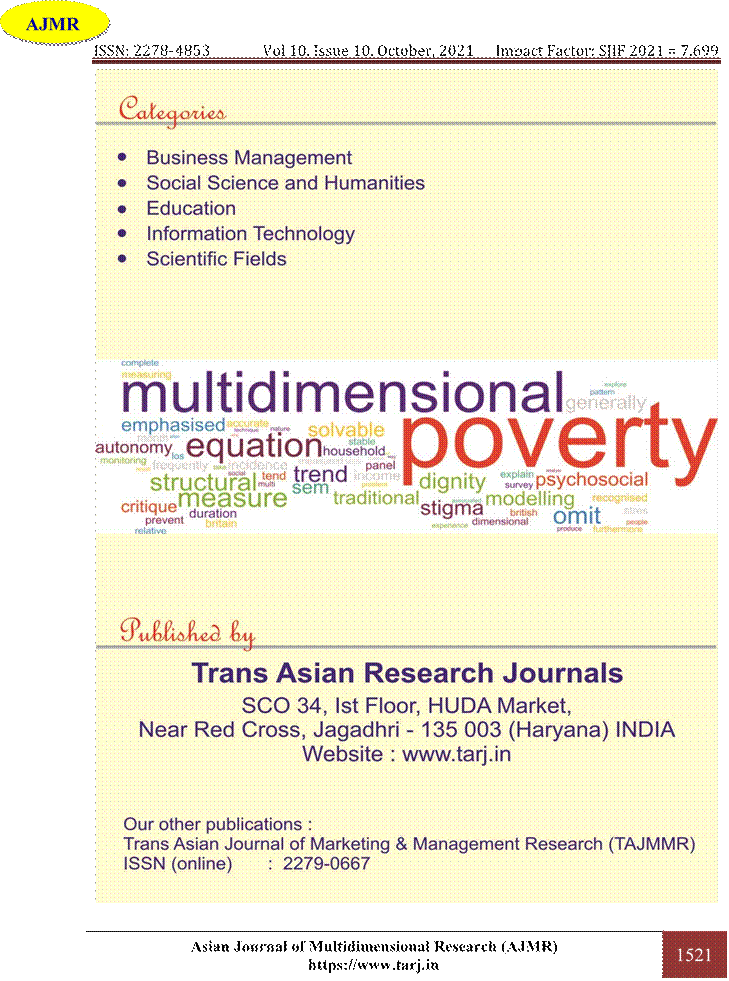


|
|
|
|
|||||
|
SR. NO . |
P A R T I C U L A R |
PAGE NO. |
DOI NUMBER |
|
|||
|
1. |
APPLICATION OF DEEP LEARNING IN MEDICAL IMAGE ANALYSIS
Dr. Ajay Rana, Dr. Nidhi Tyagi |
24-30 |
10.5958/2278-4853.2021.00798.9 |
|
|||
|
2. |
AN OVERVIEW ON TYPES OF ELECTRICAL WIRE AND ITS USES
Dr. Aniket Kumar, Rajkishor Singh, Mr. Anil Kumar |
31-38 |
10.5958/2278-4853.2021.00797.7 |
|
|||
|
3. |
DESIGN AND FABRICATION OF AQUA SILENCER: A REVIEW
Dr. Varun |
39-44 |
10.5958/2278-4853.2021.00947.2 |
|
|||
|
4. |
3D PRINTING FOR CUSTOMIZED FOOD FABRICATION
Sarita Jangra |
45-50 |
10.5958/2278-4853.2021.00949.6 |
|
|||
|
5. |
THE QUALITY OF THE WOOL FIBER OF THE OFFSPRING OBTAINED FROM THE SHEEP OF THE KARAKALPAK SUR CATTLE BREED
Parmanova Dilnoza Mavlanovna |
51-53 |
10.5958/2278-4853.2021.00763.1 |
|
|||
|
6. |
THE USE OF THE ARTISTIC TRADITIONS OF UZBEK FOLK ART IN THE LESSONS OF FINE ART
Abdirasilov Sunatulla Fayzullaevich |
54-61 |
10.5958/2278-4853.2021.00901.0 |
|
|||
|
7. |
DOPING AND STIMULANTS IN SPORTS: A MENACE AND THREAT
Dr. Anjana Lohan |
62-69 |
10.5958/2278-4853.2021.00770.9 |
|
|||
|
8. |
AN ANALYSIS OF CHALLENGES AND SIDE EFFECTS OF HEAVY METALS IN AGRICULTURE
Dr. Sudheesh Shukla, Dr. Dinesh Kumar, Dr. Divya Prakash |
70-77 |
10.5958/2278-4853.2021.00799.0 |
|
|||
|
9. |
PURSUING FIFTH GENERATION TECHNOLOGYIN MOBILE COMMUNICATION
Dr. Ajay Rana, Dr. Aniket Kumar, Mr. Anil Kumar |
78-84 |
10.5958/2278-4853.2021.00796.5 |
|
|||
|
10. |
THE BRIEF REVIEW ON THE AUTOMATIC LOAD REGULATOR
Rajkishor Singh, Dr. Aniket Kumar |
85-91 |
10.5958/2278-4853.2021.00840.5 |
|
11. |
THE ROLE AND IMPORTANCE OF PHYSICAL TRAINING AND SPORTS EXERCISES IN THE HEALTH OF A DEVELOPED GENERATION
Boratov Odiljon Muxammadjonovich, Erkaev Eldor Abdukarimovich |
92-96 |
10.5958/2278-4853.2021.00921.6 |
|
12. |
TWO-POINT SECOND BOUNDARY VALUE PROBLEM FOR A QUADRATIC SIMPLE SECOND-ORDER DIFFERENTIAL EQUATION SOLVED BY THE BERNOULLI EQUATION
M. Y. Qosimova |
97-100 |
10.5958/2278-4853.2021.00922.8 |
|
13. |
AN OVERVIEW OF DEEP LEARNING IN AGRICULTURE
Dr. Manoj Kumar, Dr. Alpana Joshi, Dr. Amit Kumar |
101-106 |
10.5958/2278-4853.2021.00839.9 |
|
14. |
DATA MINING TOOLS IN AGENT-BASED SYSTEMS: A COMPARATIVE ANALYSIS
Dr. Ajay Rana, Rajesh Pandey |
107-113 |
10.5958/2278-4853.2021.00844.2 |
|
15. |
PREDICATION OF ESSENTIALS GENES FOR RHEUMATOIDARTHRITIS USING MACHINE LEARNING
Dr. Shiva Sharma, Dr. Sudheesh Shukla, Dr. Manisha Rastogi |
114-121 |
10.5958/2278-4853.2021.00838.7 |
|
16. |
SUGARCANE VINASSE BIOGAS GENERATION: AN EVALUATION
Dr. Manisha Rastogi, Dr. Shiva Sharma, Dr. Sanjeev Kumar |
122-127 |
10.5958/2278-4853.2021.00845.4 |
|
17. |
THE DETERMINATION OF CONDENSATION PRECIPITATION ON THE INNER SURFACES OF THE LIMITATION DURING THE ACTION OF AEROSOLS
Qodirov Giyosjon Mirzajonovich, Jamoliddinova Xurshidabonu Toychiboy Qizi |
128-133 |
10.5958/2278-4853.2021.00935.6 |
|
18. |
THE USE OF INEXPENSIVE NON-WOVEN MATERIALS AS THERMAL INSULATORS IN THE INSTALLATION OF FLOOR HEATING UNITS
Homidov Voxidjon Obidovich, Yakubov Nosirjon Jurayevich |
134-137 |
10.5958/2278-4853.2021.00937.X |
|
19. |
AN OVERVIEW OF THE NETWORK TOPOLOGIES FOR ENTERPRISES
Dr. Ajay Rana, Dr. Aniket Kumar, Mr. Hamid Ali |
138-143 |
10.5958/2278-4853.2021.00826.0 |
|
20. |
ANTIMICROBIAL FINISH ON FABRICS USING PHYTOCONSTITUENTS: A REVIEW
Dr. Manisha Rastogi, Dr. Shiva Sharma, Mrs. Sarita Sharma |
144-151 |
10.5958/2278-4853.2021.00824.7 |
|
21. |
BASED ON LOCATION-SPECIFIC DATA, A TECHNOECONOMIC ANALYSIS OF SOLAR COOLING SYSTEMS IS CONDUCTED
Mr. Jitendra Kumar Singh Jadon, Rajkishor Singh, Mr. Anil Kumar |
152-158 |
10.5958/2278-4853.2021.00806.5 |
|
|
|
|
DOI:10.5958/2278-4853.2021.00935.6
THE DETERMINATION OF CONDENSATION PRECIPITATION ON
THE INNER SURFACES OF THE LIMITATION DURING THE ACTION
OF AEROSOLS
Qodirov Giyosjon Mirzajonovich*;
Jamoliddinova Xurshidabonu Toychiboy Qizi**
*Senior Lecturer,
Department of Construction of Buildings and Structures,
Fergana Polytechnic Institute, Fergana, UZBEKISTAN
Email id: qodirov105391@gmail.ru
**Student,
Faculty of Construction, Fergana Polytechnic Institute,
Fergana, UZBEKISTAN
Email id: politexbiq@gmail.com
![]()
Determination of the fallout of condensate on the inner surface of the fence when exposed to aerosols. Aerosols present in the production environment significantly affect the change in relative humidity and condensation on the inner surface of the fences and their effect must be taken into account in the calculations.
KEYWORDS:Changing Temperatures, Humidity Regime, Moisturizing The Enclosing
Structures, Saline Material, And Capillary Condensation.
![]()
In industrial buildings with aggressive environments, external walls are used in qualitatively different conditions compared to walls that are only influenced by moisture and temperature gradients.
In accordance with building codes and regulations, industrial premises of most modern chemical factories can be classified as premises with normal or even dry temperature and humidity conditions. Numerous field studies of the temperature and humidity regime of the air at potash plants confirm this statement [1-5].
However, in many cases, the walls of such buildings are covered with efflorescence and wet spots, which indicates an unfavourable humidity regime. Analysis of samples taken by the thickness of the clay brick walls shows that in some buildings the average humidity at the end of the moisture accumulation period exceeds the allowable 5%, and the local maximum humidity is higher. In the warm season, the walls do not have time to dry out. A similar picture is observed in walls made of expanded clay concrete panels with a protective layer of heavy concrete [7-12].
The increased humidity of structures in the presence of salts leads to the destruction of the wall material, especially from the outer surface, which is exposed to sharply changing temperatures. In addition, the concentration of salt dust in the outdoor air often exceeds the concentration of dust in the indoor air [13-19]. The degree of salinity, the design of the wall and some other factors affect the process of moisturizing the enclosing structures and the nature of the distribution of moisture along with the thickness of the wall. However, with the correct choice of the structural solution of the wall, the decisive influence of the salt solutions contained in the thickness of the fence on the humidity regime is undoubted, since in the pores of the wall material there are solutions of salts with physicochemical properties that differ from water.
The presence of chloride salts in the thickness of the fence increases the hygroscopicity of materials (the ability to absorb moisture from the air) [20-27]. The sorption properties of building materials are determined by the nature of the connection between moisture and the surface of pores and capillaries. The amount of adsorbed moisture in the presence of salts will depend not only on the temperature and humidity conditions of the environment and the nature of the material to be moistened but also on the physicochemical properties of salts and their amount in the pores of the material. In small pores of saline material, capillary condensation occurs when the relative humidity of the air is much lower, depending on the chemical composition of the salt and the concentration of the solution. Determination of the duration of exposure to condensate caused by aerosol hygroscopicity can be considered by the example of assessing the inner surface of the enclosing structure in buildings with aggressive environments.
The calculation of the time during which during the cold period of the year condensation will fall on the inner surface of the fences is based on the determination of the dew point temperature. The result of the calculation can serve as an approximate estimate of the time of exposure of the liquid phase to the protective coating of the fence from the inside since it is made with the following assumptions: when determining the outside air temperature, which causes condensation on the inner surface of the wall, it is assumed that the temperature of the inner surface of the wall changes instantly after the change in the outside air temperature, i.e., the thermal inertia of the wall is not taken into account. The assumption made leads to an inaccuracy in the estimate of the total time of condensate precipitation in comparison with the actual values in the direction of increase [28-34].
The total time of exposure to the liquid phase during the cold period of the year on the protective coating is determined, without taking into account periodic increases in the outside air temperature and corresponding to the increase in the temperature of the inner surface of the wall, causing interruptions in condensation, which has a positive effect on the service life of the protective coatings. Consequently, the frequency of condensation is taken into account only in the annual cycle of changes in the outdoor temperature.
The thermal engineering calculation of the fence is carried out following the chapter of SNiP on construction heat engineering. It is desirable to take real values obtained based on field studies as parameters of the internal air (temperature, humidity and aerosol properties). In the presence of hygroscopic aerosols in the air of the industrial premises, the nominal relative humidity of the air, determined by the formula
![]() в 100% ,
в 100% ,
у
г
Where в - is the relative humidity in the room,%;
г -Hygroscopicity of aerosol,%;
Depending on the temperature of the indoor air tв and the relative humidity of the indoor air, the absolute relative humidity of the air and the relative temperature of the dew point are determined. according to tables of values of maximum vapour pressure. The maximum outside air temperature at which condensate will fall out on the inner surface of the fence, under stationary heat transfer conditions and the above assumptions, can be determined by the formula
tв ру
tH tв ![]() R0
R0
Rв
where tB - indoor air temperature, ℃
ру -conditional dew point temperature of the inner surface of fences, ℃
Rв – heat resistanceм2 .ч. ℃/ kcal
The time in hours during which condensation will fall on the inner surface of the fence can be determined from the data of the SNiP chapter on construction climatology and geophysics.
Thus, it has been shown that aerosols present in the production environment significantly affect the change in relative humidity and condensation on the inner surface of the fences and their effect must be taken into account in the calculations. The studies carried out have established that the calculation of the time during which condensation will fall on the inner surface of the fences during the cold period of the year should be based on determining the dew point temperature, taking into account the assumptions of not taking into account the thermal inertia of the wall and the frequency of condensation.
How to care for concrete in the summer. If you decide to concrete any structural element in the summer, then you should understand that in summer there is high temperature and low humidity. That is why in the summertime the concreted area is covered with burlap and periodically moistened by pouring water every 2-3 hours. If the weather is not very hot, then it is worth watering every 10-12 hours. It is necessary to water the concrete within three days. This concrete care is needed in order to avoid the evaporation of water in the concrete solution itself since, without water, concrete will crack and corrode. In a humid environment, concrete gains greater strength.
How to care for concrete in winter. At a temperature of + 5-10 degrees, the hardening of concrete is significantly reduced. And at temperatures below 0, it stops. Therefore, there are three ways to heat concrete in winter. The first of these is the "thermos method". The concrete is covered with a film, and steam or warm air is allowed under this film. Because of what the concrete heats up and becomes a humid climate, which favourably affects the conditions for its freezing. The next method is "electrical heat treatment", that is, electrodes are inserted into the concrete around the perimeter and closed in one circuit, after which a current is started. And the most common way is the third - the introduction of chemical additives into concrete. There are various chemical additives that "make" the concrete mixture harden. The most common additives are calcium chloride and sodium chloride, sodium nitrate and urea. All supplements can be purchased at any hardware store.
How to choose heavy concrete. If your structure or structure is located in a humid area or a humid environment, corrosion-resistant heavy concrete should be used. So you need to cover the concreted place with dense ceramic tiles or process it with liquid glass, for complete confidence that the concrete will not corrode. If your structure or structure will be located in a room or area with a high temperature, you should use heat-resistant heavy concrete. It is also worth revealing it with ceramics or heat-resistant materials.
1. Ilyinsky VM, Building thermal physics (enclosing structures and microclimate of buildings). Ed. "High School", Moscow, 1984
2. Nabiev M.N. Humidity regime and durability of walls of industrial buildings in the presence of water-soluble salts. Dissertation, Moscow 1977
3. Fokin K.F. Building heat engineering for enclosing frequent buildings. Gosstroyizdat, Moscow, 1972
4. SNIP 2.01.01.-94 "Construction climatology and geophysics". Design standards. 1994
5. Asrorovna, A. Z. (2021). Effects Of A Dry Hot Climate And Salt Aggression On The Permeability Of Concrete. The American Journal of Engineering and Technology, 3(06), 610.
6. Makhkamov, Y. M., & Mirzababaeva, S. M. (2021). Rigidity of bent reinforced concrete elements under the action of shear forces and high temperatures. Scientific-technical journal, 4(3), 93-97.
7. Qodirov G‘.M., Yuvmitov A.S.,Sagdiev X.S.,Uktamov B.B. (2020).Assessment Of Seismic Resistance Of Existing Preschool Educational Institutions And Recommendations For TheirProvision Seismic Safety.The American Journal of Applied Sciences. 90-99.
8. Gulomiddinov S.G., Qodirov G.M., Sadirov B.T., Хaydarov A.M. (2021). Corrosion State Of Reinforced Concrete Structures. The American Journal of Engineering and Technology. 3(6). 88-91.
9. Abdukhalimjohnovna, M. U. (2021). Technology Of Elimination Damage And Deformation In Construction Structures. The American Journal of Applied sciences, 3(5), 224-228.
10. Abdukhalimjohnovna, M. U. (2020). Failure Mechanism Of Bending Reinforced Concrete Elements Under The Action Of Transverse Forces. The American Journal of Applied sciences, 2(12), 36-43.
11. Muminjon, N., & Dilshodjonugli, N. S. (2020). Improvement of transformer protection elements. Academicia: An International Multidisciplinary Research Journal, 10(6), 394-398. 12. Юнусалиев, Э. М., Абдуллаев, И. Н., Ахмедов, Ж. Д., &Рахманов, Б. К. (2020). Инновации в строительной технологии: производство и применение в узбекистане строп из текстильных лент и комбинированных канатов. In Энергоресурсосберегающие технологии и оборудование в дорожной и строительной отраслях (pp. 421-431).
13. Абдуллаев, И. Н., & Рахманов, Б. К. (2019). Распределение монтажных элементов зданий по массе для подбора грузозахватных синтетических строп в строительстве. In Наука и инновации в строительстве (pp. 188-192).
14. Abdullayev, I., &Umirzakov, Z. (2020). Optimization of bag filter designs (on
15. Ivanovna, G. N., & Asrorovna, A. Z. (2019). Technological features ofmagnetic activation of cement paste. European science review, 1(1-2).
16. Гончарова, Н. И., Мадаминов, Н. М., & Кимсанов, З. О. О. (2019). Raw architecture of the people's housing of Uzbekistan. Молодойученый, (26), 104-107.
17. Goncharova, N. I., Raxmanov, B. K., Mirzaev, B. K., & Xusainovа, F. O. (2018). Properties of concrete with polymer additives-wastes products. Scientific-technical journal, 1(2), 149152. 18. Гончарова, Н. И., Абобакирова, З. А., Абдурахмонов, Д. М., & Хазраткулов, У. У. (2016). Разработка солестойкого бетона для конструкций с большим модулем открытой поверхности. Молодой ученый, (7-2), 53-57.
19. Бахромов, М. М., & Рахмонов, У. Ж. (2019). Дефекты при проектировании и строительстве оснований и фундаментов. Проблемы современной науки и образования,
(3 (136)).
20. Mamajonov, A. U., Yunusaliev, E. M., & Mirzababaeva, S. M. (2020). Production test for producing porous filler from barkhan sand with additives of hydrocastic clay and oil waste. Academicia: An International Multidisciplinary Research Journal, 10(5), 629-635. 21. Турсунов, С., Рахмонов, Б. К., Мирзабабаева, С. М., &Игнатова, О. А. (2018).
Исследование физико-механических свойств термообработанной древесины тополя. Труды Новосибирского государственного архитектурно-строительного университета (Сибстрин), 21(2), 127-139.
22. Mamazhonovich, M. Y., & Mirzaakbarovna, M. S. (2021). To Calculation Of Bended Elements Working Under The Conditions Of Exposure To High And High Temperatures On The Lateral Force By A New Method. The American Journal of Applied sciences, 3(5), 210218.
23. Мирзаахмедов, А. Т., Мирзаахмедова, У. А., & Максумова, С. Р. (2019). Алгоритм расчета предварительно напряженной железобетонной фермы с учетом нелинейной работы железобетона. Актуальная наука, (9), 15-19.
24. Abobakirova, Z. A. (2021). Regulation Of The Resistance Of Cement Concrete With Polymer Additive And Activated Liquid Medium. The American Journal of Applied sciences, 3(04), 172-177.
25. Мамажонов, А. У., Юнусалиев, Э. М., & Абобакирова, З. А. (2020). Об опыте применения добавки ацф-3м при производстве сборных железобетонных изделий. In
Энерго-ресурсосберегающие технологии и оборудование в дорожной и строительной отраслях (pp. 216-220).
26. Usarov, M. K., & Mamatisaev, G. I. (2020, November). Calculation on seismic resistance of box-shaped structures of large-panel buildings. In IOP Conference Series: Materials Science and Engineering (Vol. 971, No. 3, p. 032041). IOP Publishing.
27. Usarov, M., Ayubov, G., Mamatisaev, G., & Normuminov, B. (2020, July). Building oscillations based on a plate model. In IOP Conference Series: Materials Science and Engineering (Vol. 883, No. 1, p. 012211). IOP Publishing.
28. Akhrarovich, A. X., & Mamajonovich, M. Y. (2021). Abdugofurovich US Development Of Deformations In The Reinforcement Of Beams With Composite Reinforcement. The American Journal Of Applied Sciences, 3(5), 196-202.
29. Asrorovna, A. Z. (2021). Effects Of A Dry Hot Climate And Salt Aggression On The Permeability Of Concrete. The American Journal of Engineering and Technology, 3(06), 610.
30. Umarov, S. A. (2021). Development of deformations in the reinforcement of beams with composite reinforcement. Asian Journal of Multidimensional Research, 10(9), 511-517.
31. Nabiev, M., GM, G. S. Q., & Sadirov, B. T. (2021). Reception of improving the microclimate in the houses of the fergana valley. The American Journal.
32. Ogli, X. A. M. (2021). Construction Of Flexible Concrete Elements In Buildings. The American Journal of Engineering and Technology, 3(06), 101-105.
33. Ogli, X. A. M. Development of effective cement additives for the production of heat-resistant concrete based on technogenic waste" International Journal of Researchculture Society. India (2019. 12. 12).
34. Davlyatov, S. M., & Makhsudov, B. A. (2020). Technologies for producing high-strength gypsum from gypsum-containing wastes of sulfur production-flotation tailings. Academicia: An International Multidisciplinary Research Journal, 10(10), 724-728.
 |
 |
Материалы на данной страницы взяты из открытых источников либо размещены пользователем в соответствии с договором-офертой сайта. Вы можете сообщить о нарушении.